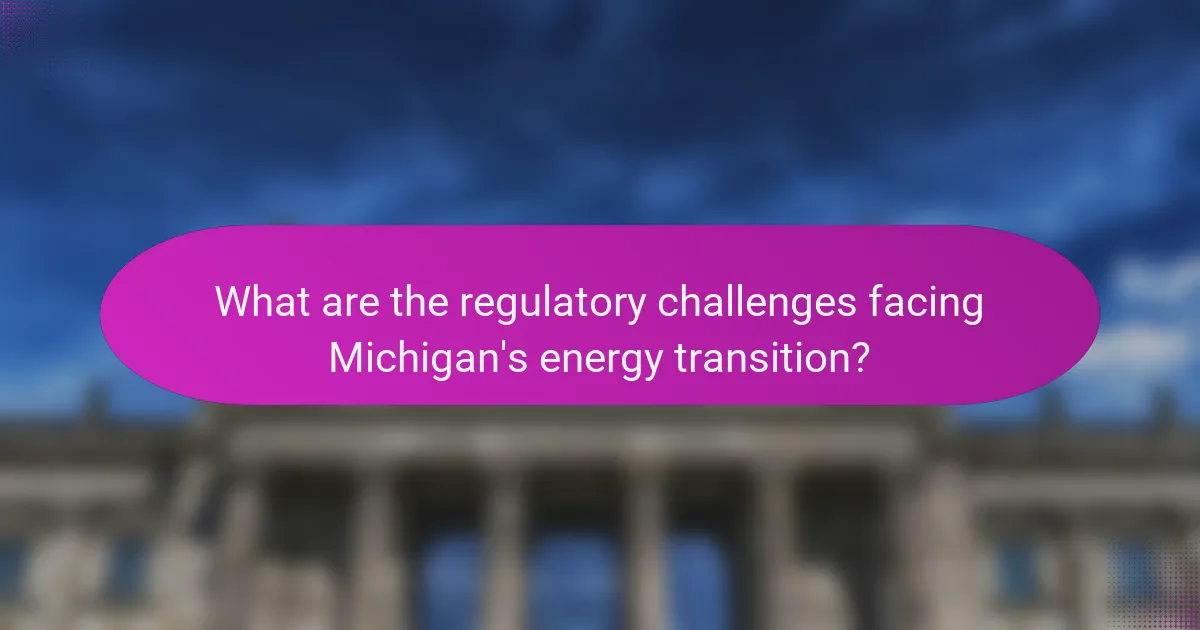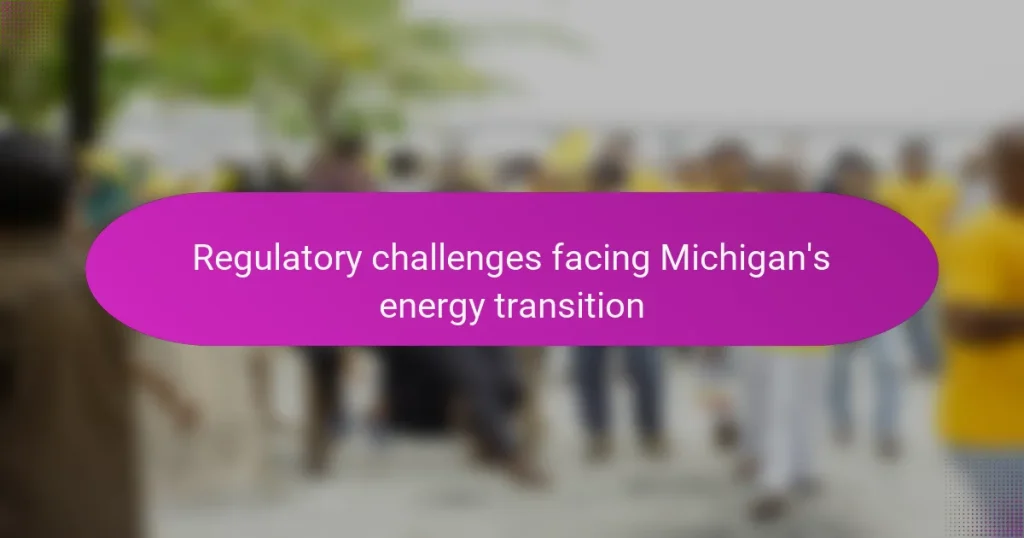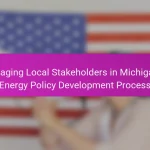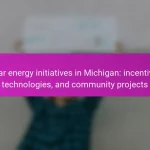
What are the regulatory challenges facing Michigan’s energy transition?
Michigan’s energy transition faces several regulatory challenges. One major challenge is the complexity of state and federal regulations. These regulations often conflict, complicating the implementation of new energy policies. Additionally, there is a lack of clear guidelines for renewable energy integration. This uncertainty can hinder investment in clean energy technologies. Another challenge is the need for updated infrastructure to support renewable energy sources. Existing infrastructure may not be compatible with new technologies. Furthermore, stakeholder engagement is essential but often insufficient. This can lead to resistance from local communities. Lastly, regulatory frameworks may not adequately incentivize energy efficiency programs. These challenges collectively impede Michigan’s progress toward a sustainable energy future.
How do current regulations impact energy transition efforts in Michigan?
Current regulations significantly influence energy transition efforts in Michigan. These regulations shape the framework for renewable energy development and emissions reductions. Michigan’s Clean and Renewable Energy Act mandates a specific percentage of energy to come from renewable sources. This requirement encourages investment in solar and wind energy projects. Additionally, regulations on emissions drive utilities to shift away from fossil fuels. The Michigan Public Service Commission oversees compliance and sets performance standards. These standards ensure that utilities meet renewable energy targets. Overall, regulations create both opportunities and challenges for energy transition initiatives in Michigan.
What specific regulations are hindering progress in Michigan’s energy transition?
The specific regulations hindering progress in Michigan’s energy transition include the state’s energy policy framework and utility regulations. The Michigan Public Service Commission oversees energy regulations, which can limit the adoption of renewable energy sources. Current laws require utilities to meet certain energy efficiency standards, but these standards may not incentivize innovative renewable projects. Additionally, interconnection regulations can delay the integration of renewable energy systems into the grid. These regulations can create barriers for new energy ventures and slow down the transition to cleaner energy sources.
How do these regulations compare to those in other states?
Michigan’s energy regulations are generally more stringent compared to several other states. For instance, Michigan mandates a 15% renewable energy standard by 2021, while states like Texas have no such requirement. Additionally, Michigan’s regulations include specific greenhouse gas reduction targets, unlike many states that lack formalized goals. The state’s focus on energy efficiency is also notable, with programs aiming for a 1% annual reduction in electricity sales. In contrast, states such as Florida do not have similar efficiency mandates. These differences highlight Michigan’s proactive stance in energy transition compared to its peers.
What role do stakeholders play in Michigan’s energy regulatory landscape?
Stakeholders play a critical role in Michigan’s energy regulatory landscape. They include utility companies, government agencies, consumer advocacy groups, and environmental organizations. Each stakeholder influences policy decisions and regulatory frameworks. Utility companies advocate for infrastructure investments and rate adjustments. Government agencies oversee compliance with state and federal laws. Consumer advocacy groups represent the interests of residential and business energy users. Environmental organizations push for sustainable practices and renewable energy adoption. Their collective input shapes the state’s energy policies and regulatory processes. For instance, the Michigan Public Service Commission engages stakeholders in discussions about energy efficiency programs and renewable energy standards. This collaborative approach helps address regulatory challenges in Michigan’s energy transition.
Who are the key stakeholders involved in Michigan’s energy transition?
The key stakeholders involved in Michigan’s energy transition include state government agencies, utility companies, environmental organizations, and consumers. State government agencies, such as the Michigan Public Service Commission, regulate energy policies and oversee utility operations. Utility companies, like DTE Energy and Consumers Energy, are responsible for providing electricity and implementing renewable energy projects. Environmental organizations advocate for sustainable practices and influence policy decisions. Consumers play a crucial role by demanding cleaner energy options and participating in public discussions. Each stakeholder contributes to shaping Michigan’s energy landscape through their unique perspectives and responsibilities.
How do stakeholder interests affect regulatory decisions?
Stakeholder interests significantly influence regulatory decisions in Michigan’s energy transition. Regulatory bodies consider the views and needs of various stakeholders, including utility companies, environmental groups, and consumers. These stakeholders often have conflicting interests. For instance, utility companies may prioritize profit, while environmental groups advocate for sustainability. The Michigan Public Service Commission must balance these interests when making decisions. Public hearings and comment periods allow stakeholders to voice their opinions. This engagement shapes policies and regulations that impact energy efficiency and renewable energy adoption. Consequently, stakeholder interests play a crucial role in determining the direction of Michigan’s energy policies.
What are the implications of regulatory challenges for Michigan’s energy future?
Regulatory challenges significantly impact Michigan’s energy future. They can lead to delays in implementing renewable energy projects. Unclear regulations may deter investment in clean energy technologies. Compliance costs can increase for energy providers, affecting pricing for consumers. Additionally, regulatory hurdles can hinder the state’s transition to a low-carbon economy. These challenges may also limit innovation in energy solutions. Overall, regulatory uncertainty poses risks to achieving Michigan’s energy goals.
How do regulatory challenges influence renewable energy adoption in Michigan?
Regulatory challenges significantly hinder renewable energy adoption in Michigan. Complex permitting processes delay project approvals. Uncertainty in state policies discourages investment. For instance, changes in renewable energy standards can create instability. Additionally, utility regulations may restrict market access for new energy providers. These barriers can lead to increased costs for developers. Consequently, fewer renewable energy projects are initiated. Overall, regulatory challenges create a less favorable environment for growth in the renewable sector in Michigan.
What risks do regulatory challenges pose to energy security in Michigan?
Regulatory challenges pose significant risks to energy security in Michigan. These challenges can lead to delays in project approvals and hinder the development of renewable energy sources. Lengthy regulatory processes may result in increased costs for energy projects. This can discourage investment in critical infrastructure. Additionally, inconsistent regulations can create uncertainty for energy providers. Such uncertainty can affect long-term planning and operational efficiency. A study by the Michigan Agency for Energy highlights that regulatory barriers can slow down the transition to a more resilient energy grid. This ultimately impacts the state’s ability to meet energy demands reliably.
How can Michigan overcome its regulatory challenges in energy transition?
Michigan can overcome its regulatory challenges in energy transition by implementing streamlined policies. Simplifying the regulatory framework can reduce compliance burdens for energy companies. Establishing clear guidelines for renewable energy projects will encourage investment. Increasing collaboration between state agencies can enhance coordination in policy enforcement. Engaging stakeholders, including local communities and businesses, can foster support for new initiatives. Providing incentives for clean energy technologies can stimulate innovation. Additionally, investing in workforce development will prepare residents for jobs in the evolving energy sector. These measures can collectively address regulatory hurdles and promote a successful energy transition in Michigan.
What strategies are being proposed to address these regulatory challenges?
Proposed strategies to address regulatory challenges in Michigan’s energy transition include enhancing stakeholder engagement and streamlining regulatory processes. Stakeholder engagement involves actively involving communities, businesses, and policymakers in energy planning. This approach fosters collaboration and ensures diverse perspectives are considered. Streamlining regulatory processes aims to reduce bureaucratic hurdles that can delay energy projects. Simplifying permitting procedures can accelerate the deployment of renewable energy sources. Additionally, creating clear guidelines for energy efficiency programs helps businesses comply with regulations more effectively. These strategies are aimed at facilitating a smoother transition to sustainable energy while addressing existing regulatory barriers.
How can collaboration improve regulatory frameworks in Michigan?
Collaboration can enhance regulatory frameworks in Michigan by fostering stakeholder engagement. Engaging diverse groups leads to more comprehensive input on regulations. This input can address various perspectives and needs, ensuring balanced policies. Collaborative efforts can also streamline communication between regulators and industry players. Improved communication helps clarify regulatory expectations and reduces compliance burdens. Additionally, collaboration can facilitate the sharing of best practices among states. This sharing can lead to more effective and innovative regulatory solutions. Evidence from other states shows that collaborative frameworks can result in quicker regulatory adaptations. For instance, California’s collaborative approach in energy policy has led to faster implementation of renewable energy initiatives.
What best practices can be adopted to facilitate a smoother energy transition in Michigan?
Adopting best practices for a smoother energy transition in Michigan includes enhancing regulatory frameworks, promoting stakeholder engagement, and investing in renewable energy infrastructure. Strengthening regulatory frameworks can streamline permitting processes for renewable energy projects. This can reduce delays and uncertainties that currently hinder development. Engaging stakeholders, including local communities and businesses, fosters collaboration and builds support for energy initiatives. This participatory approach can lead to more effective policy outcomes. Additionally, investing in renewable energy infrastructure, such as solar and wind farms, can create jobs and stimulate the economy. Michigan’s commitment to achieving 50% renewable energy by 2030 highlights the need for these practices. Implementing these strategies can facilitate a more efficient transition to a sustainable energy future.
The main entity of the article is Michigan’s energy transition, which is currently facing several regulatory challenges. Key issues include the complexity and conflict of state and federal regulations, unclear guidelines for renewable energy integration, outdated infrastructure, and insufficient stakeholder engagement. The article examines how these regulations impact energy transition efforts, comparing Michigan’s regulatory framework with those of other states, and highlights the role of various stakeholders in shaping energy policies. Additionally, it discusses the implications of these regulatory challenges for energy security and offers strategies to overcome them, emphasizing the importance of collaboration and best practices in facilitating a smoother transition to sustainable energy.


